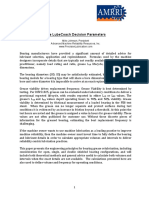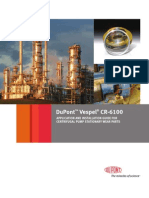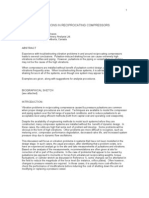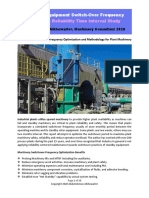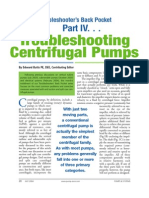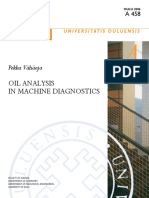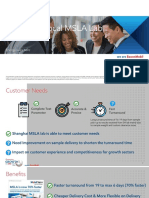Technical Topic - Lubrication Program Management
Technical Topic - Lubrication Program Management
Uploaded by
dhavit wijayantoCopyright:
Available Formats
Technical Topic - Lubrication Program Management
Technical Topic - Lubrication Program Management
Uploaded by
dhavit wijayantoCopyright
Available Formats
Share this document
Did you find this document useful?
Is this content inappropriate?
Copyright:
Available Formats
Technical Topic - Lubrication Program Management
Technical Topic - Lubrication Program Management
Uploaded by
dhavit wijayantoCopyright:
Available Formats
Technical Topic
Lubrication Program Management
Energy lives here™
A Key to Success Lubrication Management Program Goals
Regardless of industry type, maintaining a safe work place, To properly define the goals of your lubrication management
complying with applicable laws and producing profitable products program, choose from the following list (depending on what best
with maximum quality are all sound objectives for world-class meets your company’s needs):
company. But, what does it take to accomplish these objectives?
To be successful, manufacturers like yourself positively, absolutely, • Reduce lubricant related failures
require maximum equipment availability. • Use the fewest correct lubricants and minimize waste
• Apply the lubricant in the correct manner, at the proper
To make that happens, you need a disciplined, world-class time and in the correct amounts
lubrication program. This can be achieved by establishing some • Integrate the plant’s preventive and predictive maintenance
guiding principles that include: goals into the lubrication program
• Continually investigate and implement methods to improve
Setting the Implementing the and achieve the above goals
Defining the
importance of tools required to
lubrication
a lubrication achieve lubrication
management Once you’ve defined the goals of your lubrication management
management management
program goals
program program goals program, you need to be sure you have the proper tools that will
enable you to achieve these goals. No matter what method you
The Importance of a Lubrication Management Program implement, to ensure success, you should use the following tools.
Most people believe that by just maintaining or adding lubricant
to the rotating equipment provides effective lubrication. However,
by not implementing the lubrication management program, the
opportunity to optimize equipment reliability and maximize the
return on your investment may be lost. Disciplined lubrication
management is the foundation of a world-class lubrication
program. The following chart illustrates the difference made in
a plant’s total cost of ownership once you’ve taken that step.
DESCRIPTION BEFORE AFTER
Annual Lubrication Cost including Labor,
$1,055,000 $845,000
Lubricant Costs and Supply Costs
Total Annual Maintenance Budget $24,000,000 $22,000,000
Percent Annual Lubrication Costs Versus Total
4.4% 3.8%
Maintenance Budget
Lost Annual Availability Due to Scheduled and
6% 2%
Unscheduled Maintenance
Estimated Annual Profit Lost Due to Lost
$3,500,000 $1,200,000
Equipment Reliability
Annual Maintenance Department Overtime 22% 14%
Annual Number of Equipment Failures Due to
18 2
Poor Lubrication
Annual Volume of Lubricant Consumed (gallons) 62,000 15,000
Chart shows example numbers for demonstration purpose only.
Lubrication Program Management
Basic Tools Required for an Effective Program
Leadership Lubrication needs to be a priority for maintenance managers. Be sure to nominate a program
champion — someone who will assume the responsibility, accountability and control for the
program.
Standard Operating Procedures SOPs can help guarantee repeatability and quality work. SOPs also assist in the training of
(SOP’s) lubricators and enable you to track and communicate equipment condition.
Teamwork & Communication A world-class lubrication program must have a team that works and communicates with all
members of the manufacturing group-operations, maintenance, purchasing, planning and
engineering.
Lubrication Scheduling, To handle the quantity of data encountered (even for a small plant), an effective computerized
Planning, and Tracking system should be employed. Without it, important equipment trends may be missed and/or
Management Systems documentation of the lubrication program may be lacking.
Training To continually improve, both program leader and lubricators must continually learn best
lubrication practices, as well as learn new techniques in their specific discipline.
Metrics Knowing the past performance and understanding the effects of program efforts enable
you to evaluate lubrication program-related decisions. Some useful metrics are: 1. Total
maintenance costs and percentage spent on lubrication
2. Percentage of equipment scheduled and unscheduled downtime
3. Number of lubricant related failures
4. Percentage of maintenance overtime labor
5. Lubricant consumption
6. Safety incidents
Audits In order to improve, you need to validate or audit your lubrication program. Whether
performed internally or by a third party, the effort to benchmark and evaluate your lubrication
program against other “best in class” operations will supply tremendous dividends.
Conclusion
Safety, compliance, and maximum quality manufacturing are sound
objectives for a world-class company. A disciplined lubrication
management program is what’s needed to achieve these objectives.
And, when you set goals that help you succeed, you are well on
your way to establishing a world-class lubrication program.
Refs: “Lubrication Management: A Key to Success” By Tom Schiff
The Engineered Difference — Winter 2001
© 2019 Exxon Mobil Corporation. All rights reserved.All trademarks used herein are trademarks or registered
trademarks of Exxon Mobil Corporation or one of its affiliates unless otherwise noted. mobil.com/industrial
You might also like
- Life On Mars Poems by Tracy K Smith 1555975844 PDFDocument5 pagesLife On Mars Poems by Tracy K Smith 1555975844 PDFMonica Montero0% (1)
- LCE Lubrication Self-Assessment ToolDocument1 pageLCE Lubrication Self-Assessment ToolPatrick FoNo ratings yet
- Reciprocating Compressor Condition MonitoringDocument7 pagesReciprocating Compressor Condition MonitoringSantos Arauz Menacho100% (1)
- Pump Life Cycle Cost 1 Models As DefinedDocument33 pagesPump Life Cycle Cost 1 Models As DefinedRafael OrjuelaNo ratings yet
- Oil AnalysisDocument80 pagesOil AnalysisSreekumar RajendrababuNo ratings yet
- R3215-005041 Appendix A 2.0 - Datasheet For Corrosion CouponDocument1 pageR3215-005041 Appendix A 2.0 - Datasheet For Corrosion Couponsaiful anwarNo ratings yet
- BTEC Command WordsDocument1 pageBTEC Command WordsJoshKellySwagMaster2100% (2)
- Lubrication Program Development LPDDocument27 pagesLubrication Program Development LPDPatrick Fo100% (1)
- 6 Keys For A Reliability-Centered Lubrication ProgramDocument4 pages6 Keys For A Reliability-Centered Lubrication ProgramHugoCabanillasNo ratings yet
- Creating An Effective Plant Lubrication ProgramDocument6 pagesCreating An Effective Plant Lubrication Programocto widodo100% (1)
- LubeCoach Volume and Frequency Recommendations PDFDocument13 pagesLubeCoach Volume and Frequency Recommendations PDFEstebanRivera100% (1)
- Noria FML Training Brochure With ICML Certification ExamDocument7 pagesNoria FML Training Brochure With ICML Certification Examediwski100% (1)
- Basic Oil AnalysisDocument32 pagesBasic Oil AnalysishuseyinNo ratings yet
- Understanding Oil AnalysisDocument8 pagesUnderstanding Oil AnalysisTim ku100% (1)
- 100 Failure Modes of LubricationDocument5 pages100 Failure Modes of LubricationErick PachasNo ratings yet
- Best Maintenance Repair PracticesDocument4 pagesBest Maintenance Repair PracticesMahaveer SinghNo ratings yet
- Lubrication ProjectDocument23 pagesLubrication ProjectAaron Palm100% (1)
- Dupont Vespel Cr-6100: Application and Installation Guide For Centrifugal Pump Stationary Wear PartsDocument12 pagesDupont Vespel Cr-6100: Application and Installation Guide For Centrifugal Pump Stationary Wear PartsFernando Tapia GibsonNo ratings yet
- Fluid Film Bearing Damage Poster 1668361770Document1 pageFluid Film Bearing Damage Poster 1668361770Amna YahyaNo ratings yet
- Chapter 5 - Lubrication ManagementDocument41 pagesChapter 5 - Lubrication ManagementAdinz DinNo ratings yet
- Design Engineer's Guide - Selecting A Lubricant For Ball ScrewsDocument10 pagesDesign Engineer's Guide - Selecting A Lubricant For Ball ScrewsDat RomanNo ratings yet
- Vibrations in Reciprocating CompressorsDocument15 pagesVibrations in Reciprocating Compressorschaitanya_kumar_13100% (1)
- Machinery Lubrication OilersDocument0 pagesMachinery Lubrication OilerssatstarNo ratings yet
- Flushing and The Voice Within Your OilDocument4 pagesFlushing and The Voice Within Your OilHunab379No ratings yet
- Machinery Lubrication March April 2019 PDFDocument86 pagesMachinery Lubrication March April 2019 PDFJorge Cuadros BlasNo ratings yet
- Dealer Training Series: Lubrication FundamentalsDocument80 pagesDealer Training Series: Lubrication Fundamentalsbhaswath2000100% (1)
- Machinery Oil Analysis and Condition MonDocument22 pagesMachinery Oil Analysis and Condition MonAbderrahim AbarayNo ratings yet
- Rotating Equipment Switchover Frequency Reduction-2020Document10 pagesRotating Equipment Switchover Frequency Reduction-2020Abdulrahman AlkhowaiterNo ratings yet
- A Case Study of Low Speed Bearing Monitoring in A Paperboard PlantDocument9 pagesA Case Study of Low Speed Bearing Monitoring in A Paperboard PlantPIRATASANTANANo ratings yet
- Rotordynamics 2: Problems in Turbo MachineryDocument6 pagesRotordynamics 2: Problems in Turbo MachineryJessica SandersNo ratings yet
- Explanation of False Versus True BrinellingDocument7 pagesExplanation of False Versus True BrinellingHaitham YoussefNo ratings yet
- RP BearingsDocument15 pagesRP BearingsVivek RathodNo ratings yet
- Tutorial - ReliabilityDocument35 pagesTutorial - ReliabilityVictor Luiz MerlinNo ratings yet
- 3 - Compressor Best Prac - 2011 - Forsthoffer S Best Practice Handbook For RotatDocument136 pages3 - Compressor Best Prac - 2011 - Forsthoffer S Best Practice Handbook For RotatKevin_INo ratings yet
- 60 Question For Lube SuppliersDocument12 pages60 Question For Lube SuppliershungNo ratings yet
- MLT I Information EnglishDocument4 pagesMLT I Information EnglishALEXANDRE COSTANo ratings yet
- Troubleshooting Centrifugal Pumps July04!28!34Document7 pagesTroubleshooting Centrifugal Pumps July04!28!34ho-faNo ratings yet
- Controlling Coupling Guard Leakage: Rotating Equipment/MaintenanceDocument3 pagesControlling Coupling Guard Leakage: Rotating Equipment/MaintenanceinterveiwNo ratings yet
- Publication of CBMDocument108 pagesPublication of CBMMariusz RosenkrancNo ratings yet
- Principles of RotatingDocument6 pagesPrinciples of RotatingKavin adithyanNo ratings yet
- LT32599 10Document38 pagesLT32599 10Angela Bailey100% (1)
- Lubrication Degradation Getting Into The Root Causes (Sanya Mathura, Robert J. Latino-2021) (Z-Library)Document163 pagesLubrication Degradation Getting Into The Root Causes (Sanya Mathura, Robert J. Latino-2021) (Z-Library)Reinaldo Ramírez100% (4)
- Used Lube Oil Analysis & Analytical FerrographyDocument56 pagesUsed Lube Oil Analysis & Analytical FerrographyKudzie Maphy Masaire100% (1)
- CMRP Exam - Best Practices of Maintenance and Reliability - UdemyDocument11 pagesCMRP Exam - Best Practices of Maintenance and Reliability - UdemySantosh NathanNo ratings yet
- Acoustic Lubrication Handbook 2018 Web PDFDocument20 pagesAcoustic Lubrication Handbook 2018 Web PDFEswin Paico de la CruzNo ratings yet
- Lubrication Theory and Fundamentals - TransleteDocument76 pagesLubrication Theory and Fundamentals - TransleteI Wayan Arief Pradana Putra100% (1)
- Asset Criticality Ranking Value For Each Management LevelDocument6 pagesAsset Criticality Ranking Value For Each Management Levelamin32No ratings yet
- Plant Air CompressorDocument20 pagesPlant Air CompressorAndrei SavvaNo ratings yet
- Top 10 Rotating Equipment Engineer Interview Questions and AnswersDocument17 pagesTop 10 Rotating Equipment Engineer Interview Questions and AnswersSathishkumar VeluNo ratings yet
- Paper Oil Analysis in Machine Diagnostic PDFDocument80 pagesPaper Oil Analysis in Machine Diagnostic PDFj.mabukaNo ratings yet
- Machinery Lubrication November December 2017Document89 pagesMachinery Lubrication November December 2017Jorge Cuadros Blas100% (1)
- Lubrication. BasicsDocument127 pagesLubrication. BasicsKrishnan SanthanarajNo ratings yet
- RCA Next Level Failure AnalysisDocument53 pagesRCA Next Level Failure AnalysisJay100% (3)
- Constant Level Oilers - 7 Mistakes To AvoidDocument7 pagesConstant Level Oilers - 7 Mistakes To Avoiddaniel adamNo ratings yet
- Failure Analysis of A Diesel Generator Connecting Rod PDFDocument8 pagesFailure Analysis of A Diesel Generator Connecting Rod PDFLeyner Ignacio CorreaNo ratings yet
- Resolving Structural Vibration Issue On A Water Flood PumpDocument22 pagesResolving Structural Vibration Issue On A Water Flood Pumpdachrydax100% (1)
- Machinery Lubrication Sept-Oct08Document56 pagesMachinery Lubrication Sept-Oct08daniel adamNo ratings yet
- Wear: Materials, Mechanisms and PracticeFrom EverandWear: Materials, Mechanisms and PracticeGwidon W. StachowiakNo ratings yet
- Fluid Analysis for Mobile Equipment: Condition Monitoring and MaintenanceFrom EverandFluid Analysis for Mobile Equipment: Condition Monitoring and MaintenanceNo ratings yet
- Why Industrial Bearings Fail: Analysis, Maintenance, and PreventionFrom EverandWhy Industrial Bearings Fail: Analysis, Maintenance, and PreventionNo ratings yet
- PT. Berkah Anugerah Rizky Abadi Cool - Engineering Benefit Proposal - Mobiltrans HD 50WDocument9 pagesPT. Berkah Anugerah Rizky Abadi Cool - Engineering Benefit Proposal - Mobiltrans HD 50Wdhavit wijayantoNo ratings yet
- Caution - GT Ii - 14088822 - Pltgu Tanjung Batu - GG Oil - 1Document2 pagesCaution - GT Ii - 14088822 - Pltgu Tanjung Batu - GG Oil - 1dhavit wijayantoNo ratings yet
- NORMAL - Peaking#2 - 18318418502 - PLTGU TANJUNG BATUDocument2 pagesNORMAL - Peaking#2 - 18318418502 - PLTGU TANJUNG BATUdhavit wijayantoNo ratings yet
- Normal GT II 18325458507 Pltgu Tanjung BatuDocument2 pagesNormal GT II 18325458507 Pltgu Tanjung Batudhavit wijayantoNo ratings yet
- Mobilgard™ HSD 20W-50Document1 pageMobilgard™ HSD 20W-50dhavit wijayantoNo ratings yet
- GEG #1 Mobil Pegasus 805Document2 pagesGEG #1 Mobil Pegasus 805dhavit wijayantoNo ratings yet
- Mobilgard 300CDocument2 pagesMobilgard 300Cdhavit wijayantoNo ratings yet
- Mobil SHC Aware H SeriesDocument2 pagesMobil SHC Aware H Seriesdhavit wijayantoNo ratings yet
- Mobilgard M30Document2 pagesMobilgard M30dhavit wijayantoNo ratings yet
- Mobilgard M50 SeriesDocument2 pagesMobilgard M50 Seriesdhavit wijayantoNo ratings yet
- Eastman Turbo Oil 2380 - Canada - EngDocument13 pagesEastman Turbo Oil 2380 - Canada - Engdhavit wijayantoNo ratings yet
- MSLA Lab Integration Communication For DistDocument12 pagesMSLA Lab Integration Communication For Distdhavit wijayantoNo ratings yet
- Technical Topic Procedure For Flushing Oil-Flooded Rotary Screw Air CompressorsDocument2 pagesTechnical Topic Procedure For Flushing Oil-Flooded Rotary Screw Air Compressorsdhavit wijayantoNo ratings yet
- POP DELVAC1 - MX-FinalDocument2 pagesPOP DELVAC1 - MX-Finaldhavit wijayantoNo ratings yet
- Technical Topic Care and Maintenance of Mobil Aqueous Metalworking FluidsDocument2 pagesTechnical Topic Care and Maintenance of Mobil Aqueous Metalworking Fluidsdhavit wijayantoNo ratings yet
- Technical Topic - Turbine Flush GuideDocument3 pagesTechnical Topic - Turbine Flush Guidedhavit wijayantoNo ratings yet
- Mobil Delvac MX™ 15W-40 Mobil Delvac MX™ 15W-40 Mobil Delvac MX™ 15W-40 Mobil Delvac MX™ 15W-40Document4 pagesMobil Delvac MX™ 15W-40 Mobil Delvac MX™ 15W-40 Mobil Delvac MX™ 15W-40 Mobil Delvac MX™ 15W-40dhavit wijayantoNo ratings yet
- Enraf-Nonius Thermotherapy ENDocument29 pagesEnraf-Nonius Thermotherapy ENiberman PereNo ratings yet
- A Semi-Detailed Lesson Plan I. Learning OutcomesDocument3 pagesA Semi-Detailed Lesson Plan I. Learning OutcomesDela Cruz, Angelica M.No ratings yet
- Mcqs Project MGMTDocument11 pagesMcqs Project MGMTsamNo ratings yet
- Psychosocial Status and Quality of Life of Adolescent Girls in Karnataka, IndiaDocument8 pagesPsychosocial Status and Quality of Life of Adolescent Girls in Karnataka, Indiavarunendra pandeyNo ratings yet
- Iso 11660-1-2008Document28 pagesIso 11660-1-2008Rami GhorbelNo ratings yet
- Orientation ScriptDocument7 pagesOrientation ScriptJoeylhyn Pagaduan GuerreroNo ratings yet
- Selling ConceptDocument6 pagesSelling ConceptDhurba Bahadur BkNo ratings yet
- Introduction To CSiBRiDGE - Puente Sección Cajón VariableDocument58 pagesIntroduction To CSiBRiDGE - Puente Sección Cajón VariableRonald Omar García RojasNo ratings yet
- Fact Sheet - Electrician (General)Document4 pagesFact Sheet - Electrician (General)Saravanan Rasaya100% (1)
- REVIEWERDocument7 pagesREVIEWERMark Christian FloresNo ratings yet
- Evolution of RegionDocument2 pagesEvolution of RegiondasnavneepNo ratings yet
- Ontario EHR CIM 2.0Document73 pagesOntario EHR CIM 2.0KeGrNo ratings yet
- Colector Analizador de Vibraciones Falcon PDF 2 MBDocument6 pagesColector Analizador de Vibraciones Falcon PDF 2 MBGabriel Alexis MartínezNo ratings yet
- QuestionnaireDocument3 pagesQuestionnaireCoordinator MtechNo ratings yet
- Elastic Support Up To 25 KV AC: Sicat 8WL4200 For Overhead Contact Line Systems in Tunnels and Under StructuresDocument4 pagesElastic Support Up To 25 KV AC: Sicat 8WL4200 For Overhead Contact Line Systems in Tunnels and Under StructuresVictor Manuel BonettoNo ratings yet
- Online Survey Master ThesisDocument8 pagesOnline Survey Master Thesisjessicarinehartdesmoines100% (2)
- Third Cycle ProgramsDocument3 pagesThird Cycle Programsbeauty rajaNo ratings yet
- AstroCel I - Prod - Mark - Broch - AFP 1 110BDocument4 pagesAstroCel I - Prod - Mark - Broch - AFP 1 110Bjonathan Reano MendozaNo ratings yet
- ZEB HORIZON User Guide V1.2Document20 pagesZEB HORIZON User Guide V1.2Alejandro AndradeNo ratings yet
- Catalog: Control Valves For Heating, Ventilation and Air-Conditioning SystemsDocument278 pagesCatalog: Control Valves For Heating, Ventilation and Air-Conditioning SystemsandreyNo ratings yet
- Is A Process in Which Ethical Issues and Problems Are Benchmarked Against A MoralDocument3 pagesIs A Process in Which Ethical Issues and Problems Are Benchmarked Against A MoralGround ZeroNo ratings yet
- Heavyduty Kits Catalog 2017Document8 pagesHeavyduty Kits Catalog 2017panamapuro100% (1)
- NA To Sls en 1993-1-10Document12 pagesNA To Sls en 1993-1-10Shan Sandaruwan AbeywardeneNo ratings yet
- D71862GC10 1001 UsDocument4 pagesD71862GC10 1001 UsbugzbinnyNo ratings yet
- D-04 Ballast Tank Inspection Report-EnglishDocument2 pagesD-04 Ballast Tank Inspection Report-Englishjajangsuryadilaga76100% (1)
- Paper Astm StandardsDocument10 pagesPaper Astm StandardsjklelvisNo ratings yet
- Welcome To The Course On Industrial Automation and ControlDocument25 pagesWelcome To The Course On Industrial Automation and ControlvattuNo ratings yet










